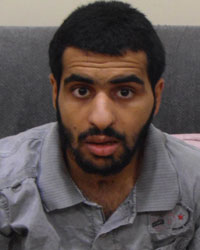Zakariya Sulaiman - Sequelae of brain injury (Oman) Posted on September 21, 2011
Name: Zakariya Sulaiman 
Sex: Male
Country: Oman
Age: 24
Diagnosis: Sequelae of brain injury
Admission Date: 2011-07-29
Days Admitted to the Hospital: 27
Zakariya was involved in a traffic accident 5 years ago, and suffered from a diffuse axonal injury. He developed difficulties with his speech, a memory impairment, balance disorder and damage to all four limbs. The damage to the left side of the body was more severe. He received a tracheotomy for 2 months to assist with the difficulty with breathing. He consistently participated in physical therapy and after some time, his cognitive ability and motor functioning showed some improvement. At present, the muscle coordination and balance is poor, Zakariya has difficulty with concentration and he is unable to walk independently.
At the time of the nervous system examination, Zakariya was alert but inarticulate. He was in good spirits but his responses were delayed and there was difficulty with concentrating, and occasional confusion. The memory was impaired, he was disoriented and his calculation abilities were poor. The right side of the nasolabial sulcus was shallow. The teeth were averted to the left side and the left cheek leaked air when the cheeks were expanded. The muscle strength of the left upper limb was level 5-, the muscle strength of the right upper limb was level 5, the muscle strength of the left lower limb was level 4, the muscle strength of the right lower limb was level 4+. The muscle tone of the left upper limb and both lower limbs was slightly high. The muscle tone of the right upper limb was normal. The radial periosteal reflex, biceps reflex, triceps reflex and patellar tendon reflex on the left side were slightly active. The radial periosteal reflex, biceps reflex, triceps reflex, patellar tendon reflex and ankle reflex on the right side were normal. The bilateral abdominal reflexes were elicited normally. The palm jaw reflex on the left side was negative, the palm jaw reflex on the right side was positive. The bilateral Rossolimo's sign was positive. The bilateral Hoffmann's sign was negative, the bilateral Babinski��s sign was positive. The positive index of the left side was higher than the right side. The bilateral superficial sensory examination was normal. The deep sensation in the left lower limb decreased gradually from the proximal-end to the distal-end. The fine sensation was normal. Zakariya was able to do the rapid rotation test and finger-to-nose test, but in an unstable way. The left side was more unstable. He was also able to do the heel-knee-shin test but in an unstable way and the left side was more unstable. When he stands with both feet at the same width of the shoulders, the body turns to the right side and bends forward. The Romberg's sign was positive. Zakariya's walking speed is slow and there is stiffness throughout his body.
We initially gave Zakariya a complete examination, and he was diagnosed with sequelae of brain injury. He was then given treatment in order to expand the blood vessels and nourish the neurons. This was combined with physical rehabilitation training.
After the completion of the treatment, Zakariya's memory, calculation abilities and orientation were better than before. He is now able to finish the finger-to-nose test and the heel-knee-shin test in a more stable manner. The Romberg's sign is no longer as severe. He has better balance and control when he stands with both feet separated at 15cms. His posture is upright and straight. The left leg has a slight limp when he walks. The muscle strength of the arms is level 5; the muscle strength of the legs is level 4+. The muscle tone of all four limbs is normal.
